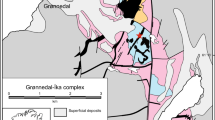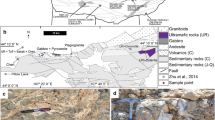Abstract
In subsurface samples of Wilcox (Eocene) sandstones, calcite cements occur above 2315 m depths, whereas ankerites occur at depths from 2560 m (temperatures 125 ° C) to at least 4650 m (temperatures 210 ° C). Microprobe analyses indicate that some shallow ankerites have appreciable excess calcium, analogous to protodomites. Ankerites at depths greater than 3200 m have compositions of about CaMg0.5Fe0.5(CO3)2.
Oxygen isotope data suggests that the ankerites are similar to low temperature hydrothermal dolomites and that they have probably formed in pore fluids with higher O18/O16 ratios than sea water. The isotopic data also suggest that the ankerites have formed over a more limited temperature interval than they occur today.
The ankerite is believed to have formed from calcite by the reaction 4CaCO3+Fe2++Mg2+=2CaMg0.5Fe0.5(CO3)2 +2Ca2+. Iron and magnesium for this reaction was apparently released by the breakdown of smectite to illite in mixed-layer clays. Bulk chemical analyses suggest that some iron was transferred from shales into sandstones. Mass balance and chemical considerations are compatible with this model.
Similar content being viewed by others
References
Al-Shaieb, Z., Shelton, J.W.: Secondary ferroan dolomite rhombs in oil reservoirs. Chadra Sands, Gialo Field, Libya. Amer. Ass. Petrol. Geol. Bull. 62, 463–468 (1978)
Boles, J.R., Franks, S.G.: Clay diagenesis in Wilcox sandstones of southwest Texas; implications of smectite diagenesis on sandstone cementation (Abstract). Amer. Ass. Petrol. Geol.-SEPM Annual Meeting, Tulsa, Oklahoma (1978)
Choquette, P.W.: Marine diagenesis of shallow marine lime-mud sediments. Science 161, 1130–1132 (1968)
Choquette, P.W.: Late ferroan dolomite cement, Mississippian carbonates, Illinois Basin, U.S.A. Bermuda Biological Station, Spec. Publ. 3 — carbonate cements (1969)
Craig, H.: Isotopic standard for carbon and oxygen, and correction factors for the mass spectrometric analysis of carbon dioxide. Geochim. Cosmochim. Acta 12, 133–149 (1957)
Curtis, C.D.: Possible links between sandstone diagenesis and depth-related geochemical reactions occurring in enclosing mudstones. J. Geol. Soc. London 135, 107–117 (1978)
Deer, W.A., Howie, R.A., Zussman, J.: Rock-forming Minerals, Vol. 5, p. 371 — non-silicates. New York: John Wiley and Sons, Inc. 1962
Dunoyer de Segonzac, G.: The transformation of clay minerals during diagenesis and low grade metamorphism: A review. Sedimentology 15, 281–346 (1970)
Ellis, A.J., McFadden, I.M.: Partial molar volumes of ions in hydrothermal solutions. Geochim. Cosmochim Acta 36, 413–426 (1972)
Engel, A.E.J., Clayton, R.N., Epstein, S.: Variations in isotopic composition of oxygen and carbon in Leadville Limestone (Mississippian) Colorado and its hydrothermal and metamorphic phases. J. Geol. 66, 374–393 (1958)
Fothergill, C.A.: The cementation of oil reservoir sands and its origin. 4th World Petroleum Cong., Sec. 1-B, 301–314 (1956)
Fritz, P.: The oxygen and carbon isotopic composition of carbonates from the Pine Point lead-zinc ore deposits. Econ. Geol. 64, 733–742 (1969)
Goldsmith, J.R., Graf, O.L., Witters, J., Northrop, D.A.: Studies in the system CaCO3-MgCO3-FeCO3: 1. Phase relations; 2. A method for major-element spectrochemical analysis; 3. Compositions of some ferroan dolomites. J. Geol. 70, 659–688 (1962)
Goldsmith, J.R., Heard, H.C.: Subsolidus phase relations in the system CaCO3-MgCO3. J. Geol. 69, 45–74 (1961)
Hower, J., Eslinger, E.V., Hower, M.E., Perry, E.A.: Mechanism of burial metamorphism of argillaceous sediment: 1. Mineralogical and chemical evidence. Geol. Soc. Am. Bull. 87, 725–737 (1976)
Howie, R.A., Broadhurst, F.M.: X-ray data for dolomite and ankerite. Am. Mineral. 43, 1210–1214 (1958)
Irwin, H., Coleman, M., Curtis, C.D.: Isotopic evidence for several sources of carbonate and distinctive diagenetic processes in organic-rich Kimmeridgian sediments. Nature, (London) 269, 209–213 (1977)
Kharaka, Y.K., Callender, E., Wallace, R.H., Jr.: Geochemistry of geopressured geothermal waters from the Frio Clay in the Gulf Coast Region of Texas. Geology 5, 241–244 (1977)
Land, L.S.: Contemporaneous dolomitization of middle Pleistocene reefs by meteoric water, North Jamaica. Bull. Marine Science 23, 64–92 (1973)
Lindholm, R.C.: Fabric and chemistry of pore filling calcite in septarian veins: Models for limestone cementation. J. Sed. Petrol. 44, 428–440 (1974)
Muffler, L.J.P., White, D.E.: Active metamorphism of upper Cenozoic sediments in the Salton Sea geothermal field and the Salton trough, southeastern California. Geol. Soc. Am. Bull. 80, 157–182 (1969)
Murray, G.E.: Geologic framework of Gulf Coast Province of United States. In: Recent Sediments, Northwest Gulf of Mexico (F.P. Shepard et al., eds.), Amer. Assoc. Petrol. Geol. Publ., Tulsa, Oklahoma, 394p. (1960)
Nash, A.J., Pittman, E.D.: Ferro-magnesian calcite cement in sandstones. J. Sed. Petrol. 45, 258–265 (1975)
Northrop, D.A., Clayton, R.N.: Oxygen-isotopic fractionations in systems containing dolomite. J. Geol. 74, 174–196 (1966)
Oana, S., Deevey, E.S., Jr.: Carbon 13 in lake waters, and its possible bearing on paeolimnology. Am. J. Sci. 258-A (Bradley volume), 253–272 (1960)
Oldershaw, A.E., Scoffin, T.P.: The source of ferroan and non-ferroan calcite cements in the Halkin and Wenlock limestones. Geol. J. 5, 309–319 (1967)
O'Neil, J.R., Clayton, R.N., Mayeda, T.K.: Oxygen isotope fractionation in divalent metal carbonates. J. Chem. Phys. 51, 5547–5558 (1969)
Perry, E., Hower, J.: Burial diagenesis in Gulf Coast pelitic sediments. Clays and Clay Miner. 18, 165–177 (1970)
Truesdell, A.H., Jones, B.F.: WATEQ, a computer program for calculating chemical equilibria of natural waters. J. Res. U.S. Geol. Surv. 2, 233–248 (1974)
Van Moort, J.C.: A comparative study of the diagenetic alteration of clay minerals in Mesozoic shales from Papua, New Guinea, and in Tertiary shales from Louisiana, U.S.A. Clays and Clay Miner, 19, 1–20 (1971)
White, D.E.: Fluids in subsurface environments. AAPG Mem 4 (A. Young and J.E. Galley, eds.), 414p. (1965).




